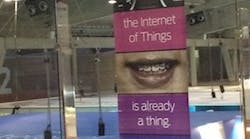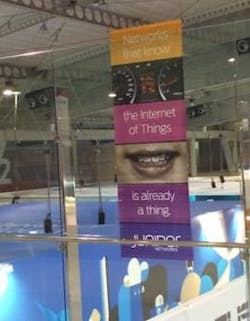Last week at Mobile World Congress in Barcelona, Internet of Things was a huge topic. Vendors for the most part seem to see sensors as another form of mobile device, whether it's built into your car, your phone, a retail display or a piece of industrial machinery.
James Bailey, who heads up the mobility practice for Accenture, said after a few years away from Mobile World Congress, he noted that the conference used to focus on handset and network providers, but today it's shifting to things like automakers, consumer electronics (like watches) and Internet of Things.
He said that Internet of Things is still a relatively small piece of the mobility practice at Accenture, but he could see a time when it eclipses the enterprise mobility business.
That includes areas like the connected home, connected health and of course the Industrial Internet of Things.
Accenture then breaks that down into various verticals such as transportation, healthcare, shipping and so forth and how sensors are affecting each of those individual industries.
He says the chief use case on the industrial side is asset monitoring, predicting when a piece of equipment is going to fail. "If a piece of equipment overheats, you don’t know until the production line is stopped. IIOT can monitor the consumption in real time on a regular basis and understand how it’s behaving differently against the norm."
Bailey says there is economic value in knowing that something is operating properly. He thinks it's going to be a big deal too, especially as the devices get smarter and the cost becomes trivial.
Many clients are using older equipment that can't necessarily take advantage of this technology, Bailey says, but as older equipment gets replaced, he believes that this equipment will get replaced with machines running smart sensors and that's when things will get really interesting.
At this stage, for many clients it's just curiosity or exploration, but he says they have recognized brand clients using sensors in a meaningful way today too, so it really falls along spectrum with those sitting back and waiting to see how it shakes out, those checking out the options and those running actual projects.
But that still leaves the question how we will interact with IIoT, and Brian Ballard, CEO at APX Labs, a company that makes a wearables agnostic development platform, thinks that wearables could be the window into the data we find there.
"We see smart glasses acting as a human-centric browser of the Internet of Things," he said.
Ballard adds, "From our view, we are introducing the human element into the Internet of Things, catering to the Industrial Internet of Things. IIoT as a construct has been very network-centric and device centric. All of that has to be in place for the IoT dream to come true, but we see it as a human problem, how do you interact [with the data]."
APX Labs sees smart glasses with hands-free access to information as a window into this information.
Bailey says ultimately IoT is a big place and trying to corner the market on it is an exercise in frustration. There's just too much happening in the space right now to completely understand the whole thing, but if we can begin to harness all of the information coming from sensors, we can use it to make better decisions and build more intelligent workflows.
What I saw at Mobile World Congress suggests that there are companies attacking those problems already, and this should get interesting over the next 12-18 months as these initial tools begin to show some maturity and achieve critical mass.
Ron Miller is a freelance technology journalist, blogger, enterprise reporter at TechCrunch and Contributing Editor at EContent Magazine. He has been writing about technology since 1988 when he began working as a technical writer. Past gigs include FierceContentManagement, CITEworld, Computerworld, TechTarget and many others. He co-founded socmedianews.com (originally socmedia101.com) in 2009 and contributes regularly to its content. You can learn more by visiting his blog, by Ron Miller at http://byronmiller.typepad.com.
Photo by Ron Miller. Used under CC by SA 2.0 license.





